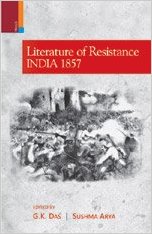Literature of Resistance: India 1857 is a compilation of academic papers pre-sented at a seminar held in late 2007 at the D.A.V. College for Girls in Yamuna Nagar, Haryana. This seminar was probably organized in keeping with a whole host of similar events funded by the Government of India and the University Grants Commission to mark the occasion of the 150th anniversary of the 1857 Uprising against the East India Company, described by V.D. Sarvakar as Indias first war of independence. Two problems commonly arise in the attempt to publish the proceedings of an academic seminar. First of all, there is bound to be unevenness in the quality of essays, which will inevitably vary from incisive scholarly insights to run of the mill observations. And secondly, most seminar organizers deliberately devise a broad based concept note in order to allow flexibility in terms of the research interests of their participants.
Accordingly, paper presenters also tailor their titles to fit into the larger framework of the conference theme. What is essential therefore in the ensuing publication is a meticulously thought-out introduction by the editors, wherein they can tie various strands together and justify disparities in thematic focus and critical methodology. Unfortunately, the editors of Literature of Resistance have made no such effort. Rather C.K. Dass short introduction merely offers a brief presentation of certain key issues and questions that haunt the narratives of Indias first war of independence (p. 1). Das rightly reminds us that Indias Sepoy Mutiny has been a contentious subject of exploration by historians and writers for the past hundred and fifty years, and will continue to generate interest and be researched for years to come (p. 1). In doing, so he builds our expectations that this collection will offer fresh perceptions and information on the complexity of the nature of events of 1857, a topic that has already generated considerable scholarship. The book however disappoints in this respect.

